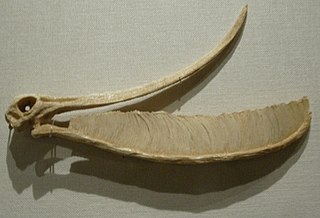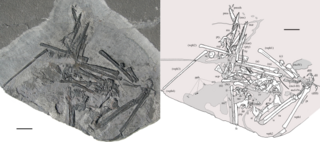
Eudimorphodon was a pterosaur that was discovered in 1973 by Mario Pandolfi in the town of Cene, Italy and described the same year by Rocco Zambelli. The nearly complete skeleton was retrieved from shale deposited during the Late Triassic, making Eudimorphodon one of the oldest pterosaurs known. It had a wingspan of about 100 centimeters (3.3 ft) and at the end of its long bony tail may have been a diamond-shaped flap like in the later Rhamphorhynchus. If so, the flap may have helped it steer while maneuvering in the air. Eudimorphodon is known from several skeletons, including juvenile specimens.

Cearadactylus is a genus of large anhanguerid pterodactyloid pterosaur from the Romualdo Formation of Brazil, South America. Fossil remains of Cearadactylus dated back to the Albian stage of the Early Cretaceous period, about 112 million years ago. The only known species is C. atrox, described and named in 1985 by Giuseppe Leonardi and Guido Borgomanero. The name refers to the Brazilian state Ceará, and combines this with Greek daktylos, "finger", a reference to the wing finger of pterosaurs. The Latin atrox means "frightful", a reference to the fearsome dentition of the species.

This phylogeny of pterosaurs entails the various phylogenetic trees used to classify pterosaurs throughout the years and varying views of these animals. Pterosaur phylogeny is currently highly contested and several hypotheses are presented below.

Peteinosaurus was a prehistoric genus of pterosaur. It lived in the late Triassic period in the late Norian age, and at a wingspan of around 60 cm (24 in), was one of the smallest and earliest pterosaurs, although other estimates suggest a wingspan of up to 1 m (3.3 ft).

The Rhamphorhynchoidea forms one of the two suborders of pterosaurs and represents an evolutionary grade of primitive members of flying reptiles. This suborder is paraphyletic unlike the Pterodactyloidea, which arose from within the Rhamphorhynchoidea as opposed to a more distant common ancestor. Because it is not a completely natural grouping, Rhamphorhynchoidea is not used as a formal group in most scientific literature, though some pterosaur scientists continue to use it as an informal grouping in popular works, such as The Pterosaurs: From Deep Time by David Unwin, and in some formal studies. Rhamphorhynchoids were the first pterosaurs to have appeared, in the late Triassic Period. Unlike their descendants, the pterodactyloids, most rhamphorhynchoids had teeth and long tails, and most species lacked a bony crest, though several are known to have crests formed from soft tissue like keratin. They were generally small, with wingspans rarely exceeding 2.5 meters, though one specimen alluded to by Alexander Stoyanow would be among the largest pterosaurs of all time with a wingspan of 10 meters, comparable to the largest azhdarchids. However, this alleged giant Jurassic pterosaur specimen is not recorded anywhere outside the original Time article. Nearly all rhamphorhynchoids had become extinct by the end of the Jurassic Period, though some anurognathids persisted to the early Cretaceous. The family Wukongopteridae, which shows a mix of rhamphorhynchoid and pterodactyloid features, is known from the Daohugou Beds which are most commonly dated to the Jurassic, but a few studies give a Cretaceous date. Furthermore, remains of a non-pterodactyloid from the Candeleros Formation extend the presence of basal pterosaurs into at least the early Late Cretaceous.
Caviramus is a genus of caviramid pterosaur from the Late Triassic lower Kössen Formation of the Northern Calcareous Alps of Switzerland.

Ornithocheiroidea is a group of pterosaurs within the extinct suborder Pterodactyloidea. They were typically large pterosaurs that lived from the Early to Late Cretaceous periods, with fossil remains found all over the world except Antarctica.

Azhdarchoidea is a group of pterosaurs within the suborder Pterodactyloidea, more specifically within the group Ornithocheiroidea. Pterosaurs belonging to this group lived throughout the Early and Late Cretaceous periods, with one tentative member, Tendaguripterus, that lived in the Late Jurassic period. The largest azhdarchoids include members of the family Azhdarchidae, examples of these are Quetzalcoatlus, Hatzegopteryx, and Arambourgiania. The Azhdarchoidea has been recovered as either closely related to the Ctenochasmatoidea, as the sister taxon of the Pteranodontoidea within the Ornithocheiroidea, or within the Tapejaroidea, which in turn was also within the Ornithocheiroidea.
Raeticodactylus is a genus of non-pterodactyloid pterosaur from the late Norian-early Rhaetian-age Upper Triassic lower Kössen Formation of the central Austroalpine of Grisons, Switzerland. It is known from holotype BNM 14524, a single disarticulated partial skeleton including an almost complete skull, found in August 2005. This genus was named and described in 2008 by its discoverer Rico Stecher; the type species is Raeticodactylus filisurensis. The specific name refers to Filisur.

Carniadactylus is a genus of pterosaur which existed in Europe during the Late Triassic period. The genus contains a single species, Carniadactylus rosenfeldi.

Archaeopterodactyloidea is an extinct clade of pterodactyloid pterosaurs that lived from the middle Late Jurassic to the latest Early Cretaceous periods of Africa, Asia, Europe and North America. It was named by Alexander Wilhelm Armin Kellner in 1996 as the group that contains Germanodactylus, Pterodactylus, the Ctenochasmatidae and the Gallodactylidae. In 2003, Kellner defined the clade as a node-based taxon consisting of the last common ancestor of Pterodactylus, Ctenochasma and Gallodactylus and all its descendants. Although phylogenetic analyses that based on David Unwin's 2003 analysis do not recover monophyletic Archaeopterodactyloidea, phylogenetic analyses that based on Kellner's analyses, or the analyses of Brian Andres recover monophyletic Archaeopterodactyloidea at the base of the Pterodactyloidea.

Novialoidea is an extinct clade of macronychopteran pterosaurs that lived from the latest Early Jurassic to the latest Late Cretaceous, their fossils having been found on all continents except Antarctica.

Eopterosauria is a group of basal pterosaurs from the Triassic, which form their own clade. The term was first used in Andres et al. (2014) to include Preondactylus, Austriadactylus, Peteinosaurus and Eudimorphodontidae. Inside the group were two other new clades, Preondactylia, which included Preondactylus and Austriadactylus, and Eudimorphodontoidea, to include Eudimorphodontidae and Raeticodactylidae. Eopterosauria was defined as "the least inclusive clade containing Preondactylus buffarinii and Eudimorphodon ranzii". The specimen BSP 1994, previously assigned to Eudimorphodon, was named the separate taxon Austriadraco in 2015, and assigned to the new family Austriadraconidae, but further classification was not described. The following phylogenetic analysis follows the topology of Andres et al. (2014).
Arcticodactylus is a genus of basal pterosaur living during the Late Triassic in the area of present Greenland. Its only species was previously attributed to Eudimorphodon, and its closest relatives may have been Eudimorphodon or Austriadraco.
Austriadraco is a genus of pterosaur living during the Late Triassic in the area of present Austria. Its only species—Austriadraco dallavecchiai—was previously attributed to Eudimorphodon, and its closest relatives may have been Eudimorphodon or Arcticodactylus.

Bergamodactylus is a putative genus of basal pterosaur which lived during the Late Triassic in the area of present-day Bergamo province in Italy. Its only species is Bergamodactylus wildi. It was named in 2015 based on a pterosaur specimen which had previously been regarded as a juvenile Eudimorphodon or as identical to Carniadactylus. Some Triassic pterosaur specialists consider the distinguishing features of Bergamodactylus to be invalid or insufficient to distinguish it from Carniadactylus, and thus retain the specimen in that genus.

Tapejaroidea is a group of pterosaurs belonging to the clade Ornithocheiroidea. Tapejaroids lived from the Early to Late Cretaceous periods, with one possible member, Tendaguripterus, extending the fossil range to the Late Jurassic period. Tapejaroidea contains two groups, the Dsungaripteridae and the Azhdarchoidea, which in turn includes the azhdarchids, the group that contains some of the largest flying animals. The group was named by Brazilian paleontologist Alexander Wilhelm Armin Kellner in 1996.
Raeticodactylidae is a family of eudimorphodontoid eopterosaurian pterosaurs that lived in Switzerland during the Late Triassic. The family includes Caviramus, and the type genus Raeticodactylus, which are both known from the Kössen Formation, around 205 mya. Raeticodactylidae was first used in 2014 by Andres et al., as a group of all pterosaurs closer to Raeticodactylus than Eudimorphodon. The following phylogenetic analysis follows the topology of Andres et al. (2014).

Seazzadactylus is a basal pterosaur genus that during the late Triassic lived in the area of present Italy.

Caviramidae is a group of basal pterosaurs. It was erected by paleontologist Matthew G. Baron in 2020. It was defined as the least inclusive clade that includes Arcticodactylus cromptonellus and Caviramus schesaplanensis.



























